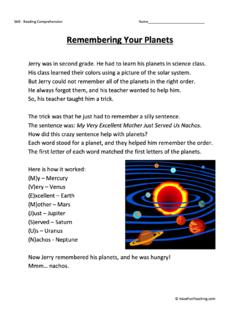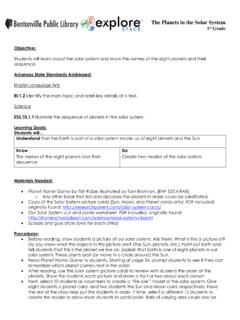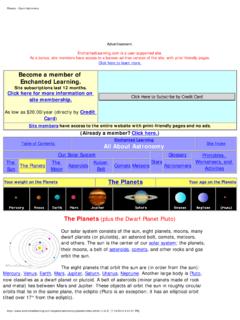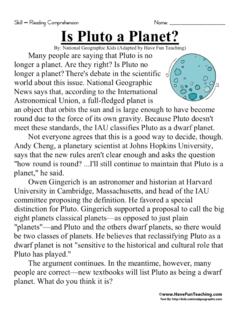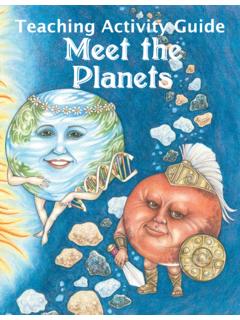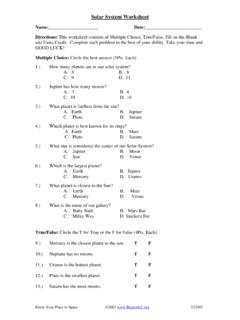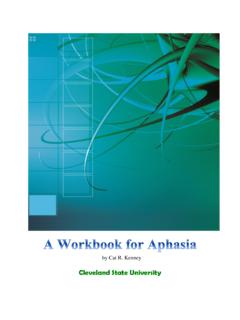Transcription of Lesson 8 – Reading and Listening for Information (optional)
1 Copyright 2005 Wheeling Jesuit University/Classroom of the Future Page 1 of 10 Lesson 8 Reading and Listening for Information ( optional ) Background Students in each of the four Specialists Teams must be able to quickly understand Information from the broadcasted messages and data transmissions from Mission Control. This Lesson , although optional , will help reinforce the students Reading and Listening skills in preparation for your Moon, Mars, and Beyond Mission. There are countless stories to use for Reading and Listening comprehension . You may want to use your Language Arts or Reading classes to reinforce these skills. Several stories about planet and moon mythology are included in these Lesson materials to relate your mission preparation to astronomy while providing students entertaining stories. Mythological stories are present in every culture and depend on the characteristics of that culture.
2 More violent cultures looked at the heavens and tended to see weapons, wars, and battles. Cultures rooted in nature tended to see animals, crops, and farmers. Legends and myths became an integral part of oral and written tradition and have provided valuable historical insights to the culture. Teacher Notes and Hints This Lesson was designed for flexibility depending on the student Reading and/or Listening skills that need reinforced. Several choices are described for teacher implementation of this Lesson . You can choose to read the myths to the students and have them answer questions relating to the stories, or you can have the students read the myths themselves. You may want to ask additional questions depending on the ability level of your students. You may want the students to keep track of how many questions they miss on each story; hopefully, they will see an improvement in their scores. If you are Reading the stories aloud for Listening practice, students will not be able to accurately spell the answers for the stories.
3 Accept answers that are close or spelled phonetically correct. There are several articles or stories from which to choose. This allows you more flexibility in using the articles for either Reading or Listening practice. Some articles are more appropriate for 4th or 5th graders if you are using the articles for Reading comprehension practice. Copyright 2005 Wheeling Jesuit University/Classroom of the Future Page 2 of 10 Several of the stories are also presented as a Task Card Activity. This will help students become more familiar with task cards and will help them practice moving from one task card to another and stopping when theyshould stop until directed to move on. Skills and Objectives Students will be able to: Practice Reading and Listening skills Find out how important Listening skills are to obtaining accurate Information Relate Reading and Listening skills to their Moon, Mars, and Beyond Mission tasks Activity Overview Students in each of the four Specialist Teams must be able to quickly understand Information from broadcasted messages and data transmissions from Mission Control.
4 In this activity, students practice Reading and Listening skills to be better prepared for their Moon, Mars, and Beyond Mission work. Students listen or read short stories about planet and moon mythology and then answer questions to test their Reading or Listening skills. Key Concepts 1. Myths about the planets and the moons have been written by many different cultures. 2. The legends and stories about the planets and moons reflect the culture of the people who wrote the myths. 3. Reading and Listening skills are important ways to get accurate Information quickly. Materials Teacher Worksheet (stories and short-answer questions) Paper (for student answers) Procedure Prior to Lesson Decide how you will conduct the Reading / Listening Lesson . If your class needs more practice in Listening , you may decide to read all the stories aloud; you may also allow the students to read some of the stories themselves to practice Reading comprehension skills.
5 Copyright 2005 Wheeling Jesuit University/Classroom of the Future Page 3 of 10 If you are going to use the Task Card Activity, copy the Student Worksheets, cut the sheets into task cards and staple. In class (Depending on teacher implementation of Reading / Listening activities) Read the stories aloud (or distribute copies of the stories) to the students. After Reading the stories, read the short-answer questions aloud and have the students answer the questions on the answer sheet. Discuss the story and questions in class and have the students keep track of how many they miss. After each story, ask the students if their Listening skills improved; discuss what they may have done differently if their skills did improve. Copyright 2005 Wheeling Jesuit University/Classroom of the Future Page 4 of 10 Teacher Worksheet & Answer Key Mythology of the Planets and Moons Jupiter Jupiter has been recognized by several cultures.
6 In both the Roman and Greek cultures, Jupiter was the ruler of the universe. He lived with the other gods on Mount Olympus and became ruler when he defeated his father, Saturn. In the Norse culture, Jupiter was known as Thor, god of Thunder; Thursday is named after Thor. Ancient astrologers noticed that Jupiter returns to each constellation every 12 years which happens to be the time it takes for one revolution around the Sun by Jupiter. Questions: 1. Who was Jupiter? Ruler of the universe 2. Where did Jupiter live? Mount Olympus 3. Who was Jupiter s father? Saturn 4. In the Norse culture, Jupiter was known Thor Saturn Saturn became ruler of the universe by defeating his father, Uranus. He then worried that his children with his wife, Rhea, would turn against him so he began to swallow them as soon as they were born. Rhea decided to hide Zeus from Saturn until he was grown. After Saturn was given a poison, he began to throw up the children who came out alive.
7 The children decided to war against Saturn until Zeus became the new ruler. Saturday is named after Saturn. Questions: 1. Who was Saturn s father? Uranus Copyright 2005 Wheeling Jesuit University/Classroom of the Future Page 5 of 10 2. What did Saturn do to make sure his children did not turn against him? He swallowed them as soon as they were born. 3. What happened to Saturn s children? He threw them up after he was given poison. Callisto (Jupiter moon; one of the Galilean moons) Callisto was a nymph (mythical young woman) who served Artemis. When Artemis got angry with her one day, Zeus changed her into a bear so she could run away. But, Artemis was an excellent hunter and he killed poor Callisto with an arrow. (Some say the Great Bear (Ursa Major) constellation refers to Callisto). Questions: 1. Who did Callisto serve?
8 Artemis 2. What did Zeus change her into? A Bear 3. What happened to Callisto? She was killed by Artemis with an arrow. The Man in the Moon There once was an Indian village where a boy name Running Antelope lived with his grandmother. He went to visit a neighboring village that was ruled by a cruel chief. The chief was very fond of a beautiful young maiden called Little Hill. When Running Antelope saw Little Hill, he fell in love with her and they were married. The chief was very angry with this and decided to get Little Hill for himself. Every night, when the people gathered in the center of the village for games, the chief would throw out beautiful and valuable pieces of coral and beads for the people to pick up. Running Antelope stayed at the games trying to pick up many beads for his new wife. When Running Antelope got back to his lodge, Little Hill was gone. He went to the chief s lodge and, as he expected, he heard Little Hill s voice.
9 He ran into the chief s house and demanded that the chief return Little Hill, but the chief pulled out a knife and Running Antelope had to run for his life! The chief chased Running Antelope shooting poisoned arrows at him. Running Antelope was just about to be caught when he came upon the lake where he prayed to the Water Spirits to save him. The Water Spirits shot a great geyser of water into the sky which hurled Running Antelope all the way to the Moon. When the chief came upon this scene, he shut his eyes in fear. So, Running Antelope was saved from the chief, but he was forever separated from his beloved wife. Running Antelope became the Man in the Moon. Copyright 2005 Wheeling Jesuit University/Classroom of the Future Page 6 of 10 That is not quite the end of the story. One day, when the chief was out near the lake, he saw the reflected image of the Moon.
10 To him, the image of Running Antelope was so vivid that he rushed in to fight him. The Water Spirits overwhelmed him with wave upon wave of water until he drowned. Questions: 1. At the beginning of the story, who did Running Antelope live with? His grandmother 2. Who did Running Antelope meet in the neighboring village? Little Hill 3. What helped to save Running Antelope from the chief s attack? The Water Spirits 4. What happened to Running Antelope? He was saved from the chief, but lost Little Hill. 5. How did Running Antelope become the Man in the Moon? The Water Spirits shot water and Running Antelope all the way to the moon to save him from the cruel chief. Apollo 13: A Successful Failure As Captain James Lovell, Commander of the ill-starred Apollo 13 Mission described it: Fred [Haise] was still in the Lunar Module. Jack [Swigert] was back in the Command Module [CM] in the left-hand seat, and I was half-way in between, in the lower equipment bay, wrestling with TV wires and a camera, watching Fred come on down, when all three of us heard a rather large bang just one bang.

